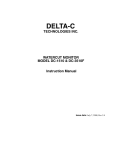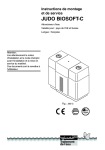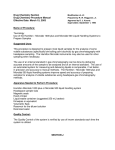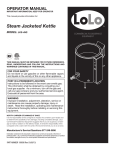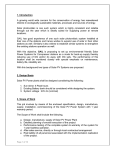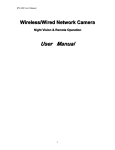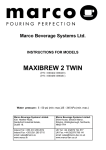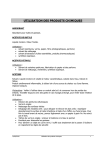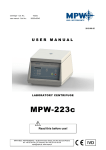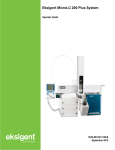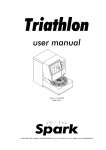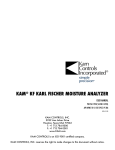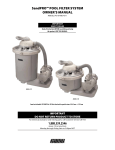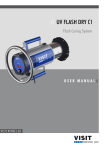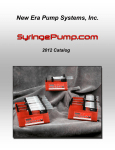Download User Manual
Transcript
User Manual Attentively read the use and installation instructions prior to any work! Should questions remain unanswered in these instructions, please contact the manufacturer. Hans Sasserath & Co. KG Safety and regulating valves Mühlenstraße 62, D-41352 Korschenbroich Postfach 1151, D-41335 Korschenbroich Phone: +49 2161 6105 - 0 Fax: +49 2161 6105 - 20 The company Hans Sasserath & Co. KG remains the owner of the copyright of the present instructions manual. No part of this publication may be reproduced, transmitted in any form or by any means or used for competitive ends without prior permission of the author. © 1701395 • 2005/06 INSTRUCTIONS for USE and INSTALLATION: IT 3000 © Copyright Hans Sasserath & Co. KG IT 3000 9.0264.04 0633 Website: www.syr.de E-Mail: [email protected] II ToC TABLE OF CONTENTS CHAPTER PAGE 1 SAFETY INSTRUCTIONS ................................................................................... 1-1 1.1 1.2 1.3 1.4 1.5 Symbols ....................................................................................................................... General safety instructions .......................................................................................... Safety instructions, Electricity ...................................................................................... Safety instructions, Salt ............................................................................................... Safety instructions, Temperature .................................................................................. 2 PREFACE ..................................................................................................... 2-1 3 HOW THE SYSTEM WORKS ............................................................................... 3-1 4 INSTALLATION SITE REQUIREMENTS ................................................................... 4-1 5 INSTALLATION / START-UP ............................................................................... 5-1 1-1 1-1 1-1 1-2 1-2 5.1 Installation ................................................................................................................... 5-1 5.2 Start-up ........................................................................................................................ 5-2 6 OPERATION / INTERRUPTION ............................................................................ 6-1 6.1 Operation ..................................................................................................................... 6-1 6.2 Interruption................................................................................................................... 6-1 7 MAINTENANCE / INSPECTION / CLEANING .......................................................... 7-1 7.1 Maintenance ................................................................................................................ 7-1 7.2 Inspection .................................................................................................................... 7-2 7.3 Cleaning ...................................................................................................................... 7-2 8 MALFUNCTIONS ............................................................................................. 8-1 9 WARRANTY .................................................................................................. 9-1 10 DIAGRAMS ................................................................................................ 10-1 13 MAINTENANCE REPORT ................................................................................ 13-1 III 1701395 • 2005/06 12 SPARE PARTS ............................................................................................ 12-1 © IT 3000 9.0264.04 0633 11 TECHNICAL SPECIFICATIONS ......................................................................... 11-1 SAFETY 1 SAFETY INSTRUCTIONS 1.1 SYMBOLS 1 INSTRUCTIONS Warning! Danger! Caution! Important instructions regarding the correct operation of the device. To be followed imperatively! 1.2 GENERAL SAFETY INSTRUCTIONS Only use original spare parts and accessories that are tested and approved by the manufacturer. The manufacturer is not liable for damages caused by the use of non-original spare parts or improper handling. For remaining questions not being dealt with in the instructions of installation and use, please contact the manufacturer. 1.3 SAFETY INSTRUCTIONS ELECTRICITY An electric shock can be lethal or cause serious injuries. Any non-authorised work on the electric system is strictly forbidden! Prior to cleaning works on the device or close to it, always unplug the apparatus as water and current form a lethal mixture! The device is delivered with a shockproof plug and shall only be plugged in a grounded shockproof socket. When no such shockproof socket is available, only qualified personnel is authorised to make the connection. The local regulations in effect (for instance EN standards in Europe) shall be observed. Only qualified service technicians are authorized to install the device. SAFETY INSTRUCTIONS, SALT The residual regeneration salt will be flushed out of the regeneration tanks along with the waste water, which should not be used for watering flowers or similar purposes. Follow the instructions in chapter “Installation site © IT 3000 9.0264.04 0633 1.4 1–1 1701395 • 2005/06 Ensure that the socket is always readily accessible. When the cable of the device is damaged, it has to be exchanged in order to avoid any risk. Unplug the device prior to changing any setting in the electronic system. SAFETY INSTRUCTIONS requirements” to ensure perfect safety as regards the drain of waste water and salt. 1.5 SAFETY INSTRUCTIONS TEMPERATURE Warning: danger of burns! Load resistances may become hot in operation and should not be touched. © 1701395 • 2005/06 IT 3000 9.0264.04 0633 Vent the water softening system right after the connection to the water mains to ensure perfect safety. 1–2 2 PREFACE 2 PREFACE To the customers' attention! you made a very good decision in selecting this water softening system, as it stands for the latest developments in the water conditioning technology. The SYR water softener IT 3000 is designed to protect pipes and water heaters against scale deposits, which reduce the water flow through the pipes and lead to a high energy consumption. The device protects the appliances and valves and prevents expensive repair works. The IT 3000 water softener is a system with two tanks, which run alternately. The ion exchanger resin is located in two separate tanks. The ion exchanger resin is regenerated in two consecutive cycles. During regeneration, the two tanks alternately ensure the soft water supply. Under consideration of the calculated flow rate capacity, the IT 3000 ensures that partially softened water is available any time at any draw-off point. Synthetic pipes or other corrosion resistant pipes shall be installed in all cases, where water of 0 ° dH (German hardness degree) flows through the pipes. Galvanized or copper tubes can be also used in case of partial softening (approximately 8 °dH), however, it is advisable to install a dosing pump in the mixed water pipe downstream of the water softener, which continuously adds a proportional amount of mineral solution to the water This allows to stabilize the remaining carbonate hardness particles and forms the prerequisite for building up a homogenous protective coating in the downstream piping system. 2–1 1701395 • 2005/06 When delivered, immediately verify that the device shows no visible damages. In case of damage caused by transport, directly contact the forwarding agency. The warranty does not cover damages caused by © IT 3000 9.0264.04 0633 The functional parts are made of high-quality materials, which all meet the local regulations and specifications. PREFACE improper handling or operation. Please refer to the terms of delivery and payment of your local dealer for any further or other claims. To ensure trouble-free functionality, the regeneration salt used must comply with the requirements of the European Standard EN 973. We recommend Broxo- or Solvay-salt (block or tabs). © 1701395 • 2005/06 IT 3000 9.0264.04 0633 We recommend to conclude a service contract to make sure that the perfect functionality of all water treatment devices is verified on a regular basis. 2–2 3 HOW THE SYSTEM WORKS 3 HOW THE SYSTEM WORKS The IT 3000 is a system with two tanks, which run alternately. The ion exchanger resin is located in two separate tanks. The ion exchanger resin is made up of small synthetic resin beads allowing the replacement of water hardness causing calcium ions with sodium ions. The water becomes "soft". However, the ion exchanger resin absorbs only a limited amount of hardness particles. Depending on the water hardness, the absorbing capacity of the resin becomes depleted sooner or later and needs to be regenerated. Regeneration in this system means removing the hardness particles from the ion exchanger resin. A diluted salt brine that flows through the resin bed removes the hardness particles, which are then directed to the sewer. The ion exchanger resin is regenerated in two consecutive cycles. During regeneration, the two tanks alternately ensure the soft water supply. As a result, the user always has soft water at his disposal, even during regeneration. The regeneration process requires only a small amount of salt. The water softening system undergoes automatic disinfection on a regular basis in order to prevent microbial growth. The amount of chlorine required for that process is generated electrolytically from the brine sucked in during regeneration. The regeneration is carried out automatically with wear-resistant ceramic disks. 3–1 1701395 • 2005/06 A water meter integrated in the device records the quantity of softened water produced, which is summed up in the electronic system. When the value that depends on the setting of the raw water hardness is reached, the electronic system triggers the regeneration process. © IT 3000 9.0264.04 0633 The regeneration process is predetermined by the geometry of the disks and does not need to be reset in case of power failure. The regeneration period lasts approximately 18 minutes for each tank, which means that softened water can be drawn off any time due to the alternately operating resin tanks. HOW THE SYSTEM WORKS © 1701395 • 2005/06 IT 3000 9.0264.04 0633 When the pressure loss in the water softening system exceeds 0.8 bar due to a considerable amount of water drawn off (for instance caused by a flushing valve), an overflow valve integrated in the control unit opens, a bypass is opened, which reduces the pressure loss and a small amount of water is not treated during that short moment. As a result, the hardness of the blended water is somewhat higher for a short while. 3–2 4 INSTALLATION SITE REQUIREMENTS 4 INSTALLATION SITE REQUIREMENTS Carefully follow these instructions to prevent any problem with the water softener. Install the water softening system in a dry room, which is not liable to frost and is equipped with a floor drain. The ambient temperature should not exceed 30 °C. The system requires a power supply (230 V, 50 Hz) under constant voltage, which is independent of the light switch. A connection to the sewer for the waste water hose and the salt tank's safety overflow is also necessary. The water softening system is usually installed behind the water meter, pressure reducing valve and backwash filter and upstream of a dosing pump and the manifold. To prevent huge damage on the installation site due to a leaking device or supply line ( for instance in an office, medical practice etc), it has to be ensured that during the personnel's absence the water and power supply are interrupted upstream of the system. However, the disconnection is not allowed during the regeneration process. Should the water and power supply be interrupted for more than 4 days, initiate a regeneration process manually, when the device is put into operation again. The resulting automatic disinfection will ensure a perfectly hygienic operation. Do not position the waste water hose above the control unit. The maximum length of the hose is 3 m. Do not extend it. Install the overflow hose with a continuous inclination towards the sewer without bending it. © 1701395 • 2005/06 IT 3000 9.0264.04 0633 The water to be softened has to be clear, free of solid impurities as well as iron and manganese-free. 4–1 5 INSTALLATION / START-UP 5.1 INSTALLATION 1. Install the flange. 2. Remove the cover of the device. 3. Mount the IT 3000 on to the flange. 4. Connect the regeneration hose to the top of the control unit (pict. 1) and pull it through the left lateral insulation to the backside of the device. 5. Fix the emergency overflow hose to the backside of the salt tank (pict. 2). 6. Bundle up both hoses and direct them to the sewer by providing a continuous gradient. Pict. 1 The upper edge of the salt tank must be positioned below the connection of the regeneration hose (pict. 1) ! © 1701395 • 2005/06 IT 3000 9.0264.04 0633 Pict. 2 5–1 INSTALLATION / START-UP 5.2 START-UP To start up the device, proceed as follows: a) To start up the apparatus, the water softening device must be connected to the water pipe, but the water supply shall not be opened yet. Do not plug in yet. b) Fill in the regenerating salt. We recommend Broxo or Solvay salt, block or tabs. When using another type of salt, the strainer in the suction hose and the salt tank need to be cleaned more often according to our experience. c) Fill 4 litres of water in the salt tank. d) Remove the cover from the control unit. Record the date of installation and the water meter reading on the relevant label and in the maintenance report (see chapter "Maintenance report"). e) Changing the preset raw water hardness: Enter the raw water hardness of your tap water in the electronic system (see DIP switch 20 and 21, pictures 3 and 4). First, determine the hardness of your tap water by means of an appropriate measuring device or ask your local waterworks. The two DIP switches 20 and 21 allow to enter this value in the electronic system: enter the decimal by means of the DIP switch 20 (see picture 3) and the unit of the raw water hardness by means of the contacts 1 to 4 of the DIP switch 21 (see picture 4). Pict. 3: Raw water hardness, decimal (DIP switch 20) Use only one contact of the decimal and one contact of the unit. IT 3000 9.0264.04 0633 England France/ Italy Pict. 4: Raw water hardness, unit (DIP switch 21) Example (raw water hardness 26 °dH): To adjust the raw water hardness to 26, push the contact 2 of the DIP switch 20 and the contact 3 of the DIP switch 21downwards. © 1701395 • 2005/06 Germany For setting the decimal and unit, push the relevant contact of the DIP switch downwards: 5–2 5 INSTALLATION / START-UP (see pict. 4). The total of the decimal and the unit amounts in this case to 20 °dH + 6 °dH = 26 °dH (German hardness degree). In the event of a raw water hardness below 10 °dH, push all contacts of the DIP switch upwards in the "OPEN" position. An acoustic signal indicates when a setting is wrong, for instance when the decimal and the unit have been adjusted to 0 °dH (see chapter "Malfunctions"). f) Changing the preset country: The contact 5 must be in the lower position (closed). The contacts 6, 7 or 8 allow to set the country, which the set raw water hardness refers to. g) Open the water supply (or the bypass valve). Vent the water softener immediately after the connection to the water network (bypass valve in operating position) to ensure perfect safety. The device is automatically vented when the initial regeneration takes place. h) Connect the device to the power supply. Each time the water softener is plugged in, the electronic system carries out a self-test, which can last up to 10 seconds. When the test is concluded with a positive result, all six LEDs light up briefly. Afterwards, the power supply LED goes on. i) Press the regeneration key to activate a manual regeneration. During the regeneration process, the left or the right salt LED goes on. © 1701395 • 2005/06 IT 3000 9.0264.04 0633 Verify the correct function of the system as described in chapter "Maintenance". When the regeneration process is finished (roughly 35 minutes), the water softener is ready to operate. The suction time should last at least one minute. Should this not be the case, verify whether a sufficient quantity of water has been filled in the salt tank (filling level of salt and water 10 - 11 cm above the bottom of the tank). 5–3 INSTALLATION / START-UP If necessary, refill water and verify the suction time by initiating a regeneration process. j) Turn the adjustment screw for the admixture of hard water so that the water downstream of the water softener gets the desired hardness usually approximately 8 °dH (German hardness degree). The measurement of the water hardness can be carried out by means of a hardness testing device. Clockwise turn (screwing in, —> Soft): softer mixed water. Anticlockwise turn (screwing out, —> Hard): harder mixed water. The adjustment screw juts maximally 1 mm out of the body. The adjustment range lies within a half-turn (Hard-Soft). The test water for measuring and adjusting the water hardness can be drawn off at a draw-off point downstream of the water softener. Prior to draw off water, ensure that the mixed water, which has undergone a new adjustment has flown through a possibly long pipe from the water softener to the drawoff point. For a correct comparison of the values measured, the test water should be drawn off at normal flow rate (1 draw-off point fully opened) without simultaneously consuming water at another spot. The standard limit value for sodium in potable water is 200 mg/l. This value does not apply to mineral and table waters, which sometimes contain more than 1.000 mg of sodium per litre. The table below "Calculation of the sodium content" allows to determine whether the blended water is still in compliance with this maximum value of the sodium content. © 1701395 • 2005/06 IT 3000 9.0264.04 0633 When the calculated total sodium content exceeds the admissible value of 200 mg/l, adjust the setting of the mixed water hardness to a higher value. 5–4 5 INSTALLATION / START-UP Calculation of the sodium content - °dh Raw water hardness (ask your local waterworks or measure with a hardness measuring device) Hardness of mixed water (value measured) = °dh Reduction of the water hardness x 8,2 mg NA/°dh sodium ions exchange value °dh = mg/l Increase of the sodium content by softening + mg/l sodium already present in the raw water (ask your local waterworks) = mg/l Total sodium content in mixed water Table 1: Calculation of the sodium content Example: calculation of the sodium content 20 °dh Raw water hardness -8 °dh Hardness of the mixed water 12 °dh Reduction of the water hardness x 8.2 98 mg/l by softening 10 mg/l from the waterworks 108 mg/l Total sodium content in mixed water Table 2: Example: calculation of the sodium content Place the cover of the control unit (2) back in its position. © 1701395 • 2005/06 IT 3000 9.0264.04 0633 k) 5–5 6 OPERATION / INTERRUPTION 6.1 OPERATION As the water softener works automatically, salt needs to be refilled only from time to time, but at the latest when the adhesive label "refill salt" becomes visible in the salt tank. Do not allow the salt stock to lower to the extent that the liquid level gets above the salt, as it would rise excessively when salt is refilled. The level of the liquid should be 10 - 12 cm above the bottom of the tank. When no softened water or just a little quantity of softened water is drawn off, the water softening system automatically carries out an additional regeneration every 4 days to ensure perfect hygiene. 6.2 INTERRUPTION Always initiate a manual regeneration process when a dismounted water softening system is re-installed and put back into operation. This allows to vent the water softener (refer to chapter "Start-up"). Protect the dismounted water softening system against frost, humidity and dirt. Place the flange cover on the connection flange to provide protection against damages (especially the sealing edges). © 1701395 • 2005/06 IT 3000 9.0264.04 0633 Should the water supply of the water softener be interrupted (main isolation closed or on "bypass"), the power supply of the device must be interrupted as well. 6–1 7 MAINTENANCE / INSPECTION / CLEANING 7 MAINTENANCE / INSPECTION / CLEANING It is recommended to carry out maintenance works at least once a year, in case of multi-family houses every six months. 7.1 MAINTENANCE Proceed as follows to service the device: 8 a) Remove the cover of the control unit (1) (fig. 2). b) Should a regeneration take place at this very moment (LED (2) or (3) is on, fig. 1), wait until it is completed. Afterwards, initiate a regeneration process by pressing the regeneration key (4). c) The operating piston turns the driver (5) (fig. 1), which drives the small gear wheel. Each lift of the operating piston causes the LED (6) to go on. The position of the driver can be read on the position indicator (7). The "sodium" position (pos. 2) is reached after two lifts. After a maximum of 15 minutes, the operating piston initiates another lift. The waste water quantity used so far amounts to approximately 4.5 litres. d) After this lift, the "backwash" position is reached (pos. 3). The resin is flushed upwards. Duration 100 seconds, waste water roughly 3 - 4.5 litres. e) Two further lifts are carried out afterwards until the position "Primary filtrate" (pos. 5) is reached. At this stage, the resin is flushed downwards (duration 100 seconds, waste water 2.5 - 4 litres). f) After two further lifts, the regeneration of the first tank is completed. Total duration:max. 18 min. The driver now turns with two lifts the right gear wheel to the position "Influx of brine" (pos. 2) to regenerate the second tank 7 Fig. 1 5 4 2 9 3 6 10 1 After this lift, the "backwash" position (pos. 3) is reached. The resin is flushed upwards (duration 100 seconds, waste water approx. 3 - 4.5 l). h) Two further lifts are carried out afterwards until the position "Primary filtrate" (pos. 5) is reached. At this stage, the resin is flushed downwards (duration 100 seconds, waste water 2.5 - 4 litres). i) After two further lifts, the regeneration of the second tank is completed and the "Operation" position (pos. 1) is reached again. The total 7–1 1701395 • 2005/06 Fig. 2 g) © IT 3000 9.0264.04 0633 After maximally 15 minutes, the operating piston initiates another lift (waste water quantity roughly 4.5 l). MAINTENANCE / INSPECTION / CLEANING duration is approximately 35 minutes. j) Should the values measured distinctly deviate from the target values (refer to chapter "Maintenance report"), inform the after-sales service. Please, always indicate the serial number, which you will find on the upper side of the device's connection flange (8). 7.2 INSPECTION Depending on the water volume used, regularly verify the salt consumption. If necessary, refill regeneration salt (use only quality complying with EN 973). Take the necessary hygienic care when refilling salt. For instance, the salt packages should be cleaned prior to use to prevent impurities from getting into the salt tank. The regenerating salt should be poured in the salt tank as soon as the package has been opened. Make sure not to overfill the salt tank and close it correctly when the work is completed. Avoid the use of opened packages. Store the salt exclusively in clean and dry rooms. 7.3 CLEANING The external surface of the water softening system can be cleaned with a usual household cleaner (soft soap). Solvents, detergents with alcohol and lacquers affect the durability of synthetic parts (danger of breaking) and shall not be used. © 1701395 • 2005/06 IT 3000 9.0264.04 0633 Should the water supply to the water softener be interrupted (main isolation closed or on "bypass"), simultaneously unplug the water softening (1). 7–2 8 MALFUNCTIONS 8 MALFUNCTIONS Malfunctions are indicated by means of two different signals: a) a red flashing LED (9) b) an acoustic signal, which lasts two minutes and is repeated every 5 hours. Cancelling the error message: Unplug (10) the device and replug after approximately 5 seconds. When the self-test is completed, the red LED (9) remains on without acoustic signal. The operating piston turns the driver (5) until the operating position is reached. Then, the red LED (9) goes out and the system is ready to operate again. When a malfunction was caused – by a temporary interruption of the pipe pressure, – by refilling salt too late, – by manual rotation of the driver during a regeneration process or – by an operating error, for instance when setting the hardness level (refer to chapter "Start-up"), just initiate a regeneration process manually to cancel the error message. © 1701395 • 2005/06 IT 3000 9.0264.04 0633 When there is no further error, the system automatically gets back to trouble-free operation. If an error message is displayed again after 5 hours, contact the customer service. In this case, unplug the device (10) and rotate the driver (5) by means of a spanner of size 13 in the operating position (pos. 1). If available, activate the bypass (refer to chapter "Interruption"). 8–1 9 WARRANTY 9 WARRANTY The operator of the device is requested to make an inspection of the device at least every two months. Warranty claims may not apply when this inspection interval is not being observed. Servicing by the manufacturer or qualified installers is also required at least once a year, in case of multifamily houses twice a year. We recommend to conclude a service contract, as it ensures best perfect functionality, also beyond the warranty period. Make sure that qualified installers or the manufacturer's customer service regularly carry out maintenance works and provide the necessary consumables or wear-out parts etc. The warranty period lasts 24 months as of the date of installation. We commit ourselves to repair or replace as quickly as possible all parts that become unserviceable during the warranty period as a result of verifiably bad materials, a defective construction or a faulty model. Our highest objective is to manufacture a high-quality product. Should you be faced with a problem, for which no solution is proposed in these instructions, contact us. We will be glad to help you. Please, always indicate the model and the serial number of the device. Our address: Hans Sasserath & Co. KG Mühlenstrasse 62 D- 41352 Korschenbroich © 1701395 • 2005/06 IT 3000 9.0264.04 0633 Phone: +49 2161 6105 - 0 Fax: +49 2161 6105 - 20 Email: [email protected] Website: www.syr.de 9–1 10 DIAGRAMS 10 DIAGRAMS Pressure loss in operating position (pos. 1) with a raw water hardness of 20 °dH (German hardness degree) and a blended water hardness of 8 °dH in dependence on the volumetric flow rate. Diagram 1 Pressure loss in operating position 1701395 • 2005/06 Diagram 2 Draw-off quantity per day © IT 3000 9.0264.04 0633 Max possible draw-off quantity per day depending on the raw water hardness with a blended water hardness of 8 °dH (German hardness degree). 10 – 1 DIAGRAMS Max. possible permanent draw-off quantity depending on the raw water hardness with a blended water hardness of 8 °dH (German hardness degree). Diagram 3 Permanent draw-off quantity IT 3000 9.0264.04 0633 Diagram 4 Waste water quantity © 1701395 • 2005/06 Waste water quantity per 1 m3 of blended water with a 8 °dH hardness (German hardness degree) in dependence on the raw water hardness. 10 – 2 10 DIAGRAMS Salt consumption per 1 m3 of blended water with a 8 °dH (German hardness degree) hardness in dependence on the raw water hardness. © 1701395 • 2005/06 IT 3000 9.0264.04 0633 Diagram 5 Salt consumption 10 – 3 TECHNICAL 11 SPECIFICATIONS 11 TECHNICAL SPECIFICATIONS 1.7 m3/h Nominal capacity: 0.9 mol Nominal pressure: PN 10 Capacity per kg of salt: 5 mol Min. operating pressure: 2 bar Max. operating pressure: 7.0 bar Max. operating temperature: 30 °C Pressure loss at nominal flow rate: 0.5 bar Salt stock: 40 kg Power supply: 230V / 50Hz / 15W Salt consumption and waste water per m3 as well as pressure loss and max. draw-off quantity: see chapter "Diagrams" © 1701395 • 2005/06 IT 3000 9.0264.04 0633 Nominal flow rate: 11 – 1 12 SPARE PARTS 12 SPARE PARTS 1 1 Cover 3000.00.900 2 Salt tank 3000.00.901 3 Insulating cover 3000.00.902 5 8 10 9 7 4 Board 3000.00.903 4 5 Driver 3000.00.904 * 6 Regeneration tank 3000.00.905 7 Injector 3000.00.906 3 3 11 6 * 8 13 Regeneration cartridge 3000.00.907 *** 9 Suction indicator 3000.00.908 *** 2 10 Bypass valve 3000.00.909 **** 11 Pressure reducing valve 3000.00.910 *** 12 12 Suction strainer 3000.00.912 * 13 Cover of salt tank 3000.00.914 Exchange intervals: * = 1 year, ** = 2 years, *** = 3 years, **** = 4 years Double connection flange (parallel flange) 2315.32.030 (DN 32) 2315.40.030 (DN 40) 2315.50.030 (DN 50) 12 – 1 1701395 • 2005/06 Titration test IT 3000 3000.00.913 Y-distribution flange 2315.00.071 © IT 3000 9.0264.04 0633 not shown in fig.: Regeneration salt 3000.00.911 MAINTENANCE 13 REPORT 13 MAINTENANCE REPORT Date of installation: Network pressure: Date: Raw water hardness measured [°dH]: set [°dH]: Blended water hardness measured [°dH]: Water meter [m3]: S No. of regenerations 1 L N M Suction time 2 [minutes] (max. 15 min.) Waste water quantity [Litre] (max. 4.5 litres) Flushing out 4.5 litres) 3 (3 - Primary filtrate 4 (2.5 - 4 litres) 3 4 N = Normal regeneration, Values for suction time, waste water quantity, flushing out and primary filtrate applicable to relevant regeneration step © IT 3000 9.0264.04 0633 2 filled in by customer service ( S = Total sum, L = Prolonged influx of brine, M = shortened influx of brine) Position 2 Position 3 Position 5 13 – 1 1701395 • 2005/06 1


























